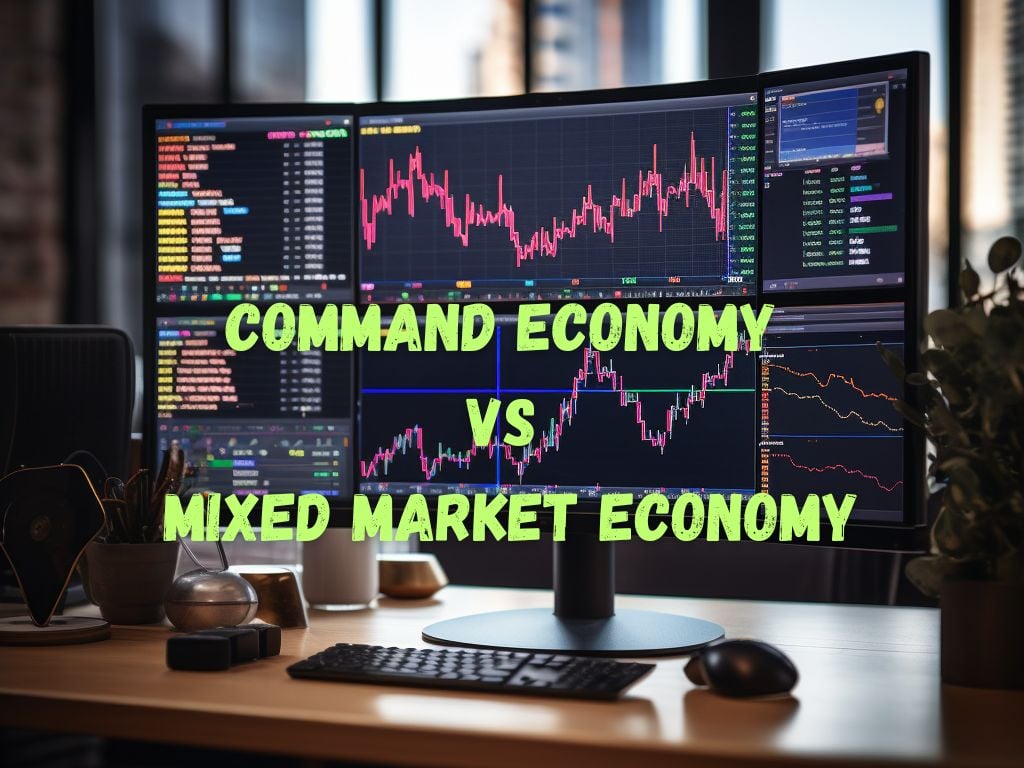When it comes to understanding economic systems, two main models often come to mind: the command economy and the mixed market economy.
These two systems represent different approaches to resource allocation and decision-making.
In this article, we will delve into the world of command vs mixed market economy to explore their characteristics, advantages, and disadvantages of each system and compare them side by side to gain a comprehensive understanding of their workings and implications.
Characteristics of Command Economy
A command economy is a system in which the government makes all the major economic decisions and controls the allocation of resources.
Some of the key characteristics of a command economy include:
- Centralized decision-making: All economic decisions, from what to produce and how much to produce to how it should be distributed and at what price it should be sold, are made by the central government.
- Limited private ownership: The government owns and controls most of the industries and resources, allowing only minimal private ownership.
- Absence of price mechanism: In a command economy, prices are set by the government, rather than by market forces, leading to the absence of a price mechanism based on supply and demand.
- Lack of economic freedom: Economic freedoms such as the ability to start and operate a business are severely restricted.
- Prioritizes societal needs: The government allocates resources based on societal needs, focusing on areas such as education, healthcare, and infrastructure.
- Redistributes wealth: A command economy aims to address wealth inequality by redistributing wealth more equitably among the population.

Advantages and Disadvantages of Command Economy
Advantages of a command economy
- Efficient allocation of resources: With central planning, the government can prioritize the distribution of resources based on societal needs and direct investment towards key sectors.
- Reduced wealth inequality: A command economy aims to redistribute wealth more equitably among the population, reducing income disparities.
- Stability: With the government controlling prices and production levels, the economy is less prone to market fluctuations and instabilities.
Disadvantages of a command economy
- Lack of individual freedom and initiative: Entrepreneurs and individuals are limited in their ability to start businesses or make economic decisions independently.
- Inefficient resource allocation: Centralized decision-making may result in inefficient resource allocation since the government may not have access to up-to-date information about market conditions and consumer preferences.
- Limited innovation: The lack of individual initiative and entrepreneurial spirit can hinder innovation and technological advancement.
- Bureaucratic inefficiencies: Central government control can create delays and inefficiencies in decision-making processes.
Characteristics of Mixed Market Economy
A mixed market economy combines elements of government control and market mechanisms. Some of the key characteristics of a mixed market economy include:
- Private ownership: Private businesses own and control the industries and resources, with the government playing a regulatory role.
- Decentralized decision-making: Economic decisions are made by individual firms and consumers in response to market conditions, rather than by the government.
- Price mechanism: Prices are determined by the interaction of supply and demand in the market, reflecting the preferences of consumers.
- Economic freedom: Individuals have the freedom to make their own economic decisions, such as starting a business or choosing which goods and services to purchase.
- Government regulation: The government enforces laws to ensure fair competition and protect consumer interests.
Advantages and Disadvantages of a Mixed Market Economy
Advantages of a mixed market economy
- Economic freedom: Individuals have the freedom to make economic choices, leading to a wider range of goods and services available in the market.
- Efficiency: Market forces promote efficiency in resource allocation, as businesses have the flexibility to adjust to changing consumer demands.
- Innovation: A mixed market economy encourages entrepreneurship and innovation, promoting technological advancement and overall economic growth.
Disadvantages of a mixed market economy include
- Income inequality: The distribution of wealth is largely determined by market forces, leading to income disparities and wealth concentration in the hands of a few wealthy individuals or corporations.
- Market failures: Externalities and monopolies may occur, leading to market failures and exploitation. Government intervention is necessary to prevent such situations and ensure fair competition.

Comparison between Command vs Mixed Market Economy
When comparing command economies and mixed market economies, several key differences emerge.
Economic Decision-Making
In a command economy, the government holds the decision-making power, determining what and how much to produce.
In a mixed market economy, decision-making is decentralized, with market forces influencing production decisions.
Role of Government
Command economies rely heavily on government control and central planning, leading to limited private ownership.
In mixed market economies, the government plays a regulatory role to ensure fair competition and protect consumer interests, while private ownership prevails.
Efficiency and Resource Allocation
Command economies prioritize equitable distribution of resources based on societal needs, often at the expense of market efficiency.
In contrast, mixed market economies rely on market forces to allocate resources efficiently, but this may result in income disparities.
Economic Freedom and Individual Choice
Command economies limit individual freedom and choice, as economic decisions are made by the government.
In mixed market economies, individuals have the freedom to make economic choices, leading to a wider range of goods and services available in the market.
As an example, the former Soviet Union and China have followed command economies while the United States, Germany, and Canada are examples of mixed market economies.
In conclusion, understanding the subtle differences between these economic systems is crucial to build a sustainable future economy that is efficient, innovative, fair, and thriving.

Frequently Asked Questions
What are the pros and cons of a command economy compared to a mixed market economy?
Command economies offer efficient resource allocation and reduced wealth inequality, but restrict individual freedom and may lead to inefficient decision-making.
Mixed market economies provide economic freedom and efficient resource allocation but can result in income inequality and market failures.
Can a country have elements of both command and mixed market economies?
Yes, some countries adopt mixed economic systems with varying degrees of government intervention in the market. These economies strike a balance between government control and the free market.
What are some examples of industries or sectors that are typically controlled in a command economy?
In a command economy, major industries such as energy, transportation, and infrastructure are often controlled by the government to ensure central planning and allocation of resources.
Conclusion
In conclusion, the choice between a command economy and a mixed market economy has far-reaching effects on society and businesses.
Each system has its own strengths and weaknesses, with command economies emphasizing central planning and equitable resource allocation, while mixed market economies prioritize economic freedom and efficiency through market forces.
Understanding the characteristics, advantages, and disadvantages of these systems allows us to appreciate the complex nature of economic systems and their impact on our everyday lives.


 Tags:
Tags:










